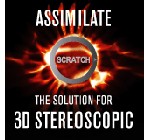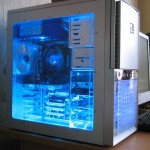Blog Archives
‘Assimilate’ Adds New Fire With Scratch v.5.1
 SCRATCH the’ Digital Finishing Solution’ by Assimilate is billed by the company as the essential mix for a real-time, resolution-dependent data workflow.Riding the RED MX Wave and beyond: The RED-ONE Digital Camera has taken the entertainment world by storm. Assimilate’s Scratch 5.1 leads the industry with first support for RED cameras, such as support for multiple RED Rocket cards in a single SCRATCH system; first dual RED Rocket support for MX R3D; and first non-RED application to support the new RED MX sensor and revised color math, with native real-time playback and adjustment of all on-camera color parameters, such as FLUT, exposure, and curves. Working easily with the native R3D files, SCRATCH streamlines the RED ONE MX workflow and delivers a high-quality master for multiple delivery formats.
SCRATCH the’ Digital Finishing Solution’ by Assimilate is billed by the company as the essential mix for a real-time, resolution-dependent data workflow.Riding the RED MX Wave and beyond: The RED-ONE Digital Camera has taken the entertainment world by storm. Assimilate’s Scratch 5.1 leads the industry with first support for RED cameras, such as support for multiple RED Rocket cards in a single SCRATCH system; first dual RED Rocket support for MX R3D; and first non-RED application to support the new RED MX sensor and revised color math, with native real-time playback and adjustment of all on-camera color parameters, such as FLUT, exposure, and curves. Working easily with the native R3D files, SCRATCH streamlines the RED ONE MX workflow and delivers a high-quality master for multiple delivery formats.
With 3D in full gear, Assimilate has given post artists the ability to work in real-time 3D at all times with direct output to any stereoscopic display system. Additionally. Assimilate offers post houses it’s exclusive 3Play Pro, which enables playback and review of full-resolution HD stereoscopic material on a variety of consumer 3D monitors, as well as non-3D monitors using a variety of Anaglyph formats. With enhanced color grading along with finishing and compositing, Scratch v.5.1 also offers support that reads and writes every DNxHD format, which provides full compatibility with AVID media for projects originating on Media Composer, Symphony, or DS.
Assimilate’s Scratch v.5.1 will be on display at this years NAB with multiple booths for those eager to test out the new features and take a test run on what is proving to be a valuable asset to those in the post community.
How strong should an NLE system be?
 This is an often frustrating topic for myself. I see so many companies and editor’s picking up the latest NLE or animation program and then nickle and diming their way through the actual hardware which they run on. This couldn’t be a bigger mistake then was Sarah Palin’s political aspirations. In defence of some of these people, they really don’t know their undermining the workflow process when they cheap out of hardware, or better still, they don’t think their cheaping out. But the facts are, if you plan on doing ANY multi-program work ( ie working in Avid while using After Effects /Photoshop ) or simply working in HD your just begging for corruption or freezing without the proper setup.
This is an often frustrating topic for myself. I see so many companies and editor’s picking up the latest NLE or animation program and then nickle and diming their way through the actual hardware which they run on. This couldn’t be a bigger mistake then was Sarah Palin’s political aspirations. In defence of some of these people, they really don’t know their undermining the workflow process when they cheap out of hardware, or better still, they don’t think their cheaping out. But the facts are, if you plan on doing ANY multi-program work ( ie working in Avid while using After Effects /Photoshop ) or simply working in HD your just begging for corruption or freezing without the proper setup.
So here’s the deal. What any editor needs ( especially if he or she is working in HD, which most likely these days is a given ) is a quad-core processer at MINIMUM. You hear that? M-I-N-I-M-U-M. Not a dual core, not a very fast this or that, but a quad-core at minimum. I say at minimum, because with the new i7 processors ( which I recently upgraded to ) and the 64 bit platforms things are just going to get faster and more optimized, but for now, that’s your minimum for processors.
Next is your graphics card. A quick note for all of you, these programs are being more GPU focused so your graphics card is beginning to take over more and more of the rendering duties as well as the ability to display your graphics and video. So you need to buy a high end, yes that’s right, a high end graphics card to handle these responsibilties. How high end? Well, I’m not made of money either, so when I say high end, I mean a graphics card with a minimum of 1 gig of ram ( yes you will need that), at a cost of around $250 and up. I say $250 because there are really really cheap graphics cards which hold 1 gig of ram but are absolute garbage and move at a snails pace or break after one month, so be careful. By a name brand, ( or supported affiliate) and don’t get suckered into a 1 gig $99 dollar piece of crap. Always remember, there’ s a reason why it’s that cheap compared to another card of seemingly equal specs.
Your platform. 64 bit is definitely the way to go for the new blood of editor’s. The ” not a lot of programs use 64 bit…” argument is about as pathetic as it comes. It doesn’t matter if EVERY program is going to utilize the 64 bit optimized engine, the point is, they are starting to. Adobe CS4 is completely optimized as a 64 software package, and you know what? If your software isn’t, so what! 64 bit is backwards compatible to 32 bit so you can still run your other software while having the benefit of the ones that do run at the higher bit. And yes, as per my Adobe CS4 blog earlier, it does make a difference.
The final and most overlooked aspect I find is the ram. If your running 4 gigs of ram while trying to multi-task with After Effects and Avid / FCP your just begging for problems, especially if running anything in HD. These programs ( and most others ) utilize at least 3 gigs of ram on their own. If your holding 4 gigs or ram while operating two or even three of these programs, exactly how to think the computer can handle that. If your running a higher end Mac or Vista operating system you can hold up to 32 gigs of ram and have it properly distributed by the OS. That would technically mean that you can run AE, FCP and Photoshop ( given that the rest of your hardware is solid) and you wouldn’t notice a difference in speed. So remember to get a proper platform that can handle more than 4 gigs of ram and then load in the ram. My experience is that currently 12 gigs will take care of all your needs while multiply applications running at full tilt.
So there it is for you. I would advise that you heed this advice seriously, otherwise you’ll be one of those ignorant persons either blaming you editor for not working fast enough or complaining that your computer or software stinks. From an experience standpoint I can assure you, about 99% of issues with glitches or crashing in regards to post production comes down to the hardware and system setup. So don’t skimp and you’ll avoid the headaches.
Adobe CS4, welcome to the world of 64
 Ever since the inception of Adobe’s various software programs, they seem to have maintained a pretty solid reputation in certain circles. Certainly Flash, Dreamweaver, After Effects, and of course, the most popular amonst the public, Photoshop. Over the years they have released different versions, always promising leaps and bounds but not all the upgrades have been worth the additional funds. Well, here we go again. Adobe CS4. The newest in a long line of software upgrades, which like all the ones before it, promise new features and better workflow, so the question is, is it worth it?
Ever since the inception of Adobe’s various software programs, they seem to have maintained a pretty solid reputation in certain circles. Certainly Flash, Dreamweaver, After Effects, and of course, the most popular amonst the public, Photoshop. Over the years they have released different versions, always promising leaps and bounds but not all the upgrades have been worth the additional funds. Well, here we go again. Adobe CS4. The newest in a long line of software upgrades, which like all the ones before it, promise new features and better workflow, so the question is, is it worth it?
The answer really comes in two different forms, I know that’s not what some want to hear, they just want a quick YES or NO but really it’s not that simple. While some of the programs such as Flash have had their workflow changed from their standard layout and have had some intuitive features added such as object based animation, 3D transformations, and meta data support, just to name a few, really most haven’t done too much. And unless you’ve been living with Adobe Cs2 for the past two years, I can’t really seem to think that most will find these editions something they’ll “need” to continue to serve their clients. However, there is one BIG factor that may sway those to open their wallets. Adobe CS4 is now optimized to run in a 64 bit platform, which may sound like a gimmic but having tested the difference I can assure you that this should be taken under serious consideration for those who consider time and efficiency a factor in their work. For myself, working with CS4 After Effects on a 64 bit Vista platform, while maybe not black and white, did made a difference, and was still noticable enough for me to say “Hmm, now THATS interesting…”
Overall I would say if your working well with CS3 and booting along fine, don’t bother, but if your looking for an edge, and have the system to run it, you may want to grab the new Adobe Cs4 either packaged or indiviually, because you WILL notice a better performance from a 64 bit platform. I’ve included an interesting look at one of the new features in Adobe After Effects CS4 via video below, it’s called the Cartoon Effect.
